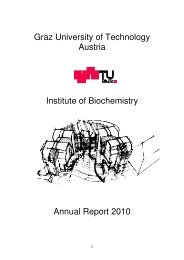Staff Members of the Institute of Biochemistry, TU - Institut für ...
Staff Members of the Institute of Biochemistry, TU - Institut für ...
Staff Members of the Institute of Biochemistry, TU - Institut für ...
Create successful ePaper yourself
Turn your PDF publications into a flip-book with our unique Google optimized e-Paper software.
Although <strong>the</strong> chemical structures <strong>of</strong> nikkomycins have been known since <strong>the</strong> 1970s, only a<br />
few biosyn<strong>the</strong>tic steps have been investigated in detail. The steps leading to <strong>the</strong> syn<strong>the</strong>sis <strong>of</strong><br />
aminohexuronic acid are unclear. The biosyn<strong>the</strong>sis commences with <strong>the</strong> attachment <strong>of</strong> an<br />
enolpyruvyl moiety to <strong>the</strong> 3´-position <strong>of</strong> UMP. Since none <strong>of</strong> <strong>the</strong> nikkomycins syn<strong>the</strong>sized<br />
possess an enolpyruvyl group in this position <strong>of</strong> <strong>the</strong> sugar moiety, it must be concluded that<br />
<strong>the</strong> resulting 3’-enolpyruvyl-UMP is subject to rearrangement reactions where <strong>the</strong><br />
enolpyruvyl is detached from its 3’-position and transferred to <strong>the</strong> 5’-position <strong>of</strong> <strong>the</strong> ensuing<br />
aminohexuronic acid moiety. Co-crystallization <strong>of</strong> NikO with fosfomycin yielded rod – like<br />
crystals diffracting up to 2.5 Å. A synchrotron dataset was measured at <strong>the</strong> Swiss Light<br />
Source and <strong>the</strong> structure was solved by molecular replacement using UDP-Nacetylglucosamine<br />
enolpyruvyl transferase (PDB code: 2rl1) as a model. Two molecules were<br />
found in <strong>the</strong> asymmetric unit exhibiting an inverse α,β-barrel fold with helices forming <strong>the</strong><br />
tightly packed core and sheets shielding <strong>the</strong> hydrophobic core from <strong>the</strong> solvent:<br />
Each chain is comprised <strong>of</strong> two inverse α,β-barrel subunits, which are connected by a hinge<br />
region. The final structure was refined to final R/Rfree values <strong>of</strong> 17% and 19%, respectively.<br />
The genes that are co-transcribed with nikO have been reported and are designated as<br />
nikI, nikJ, nikK, nikL, nikM and nikN. In order to investigate <strong>the</strong> role <strong>of</strong> <strong>the</strong> encoded proteins<br />
in <strong>the</strong> biosyn<strong>the</strong>sis <strong>of</strong> <strong>the</strong> aminohexuronic acid moiety, <strong>the</strong>se genes were cloned, expressed<br />
and <strong>the</strong> proteins purified for biochemical characterization and crystallization. Fur<strong>the</strong>rmore,<br />
nikkomycin intermediates produced by Streptomyces mutants featuring disruptions <strong>of</strong> <strong>the</strong><br />
respective genes were analyzed, but no nikkomycins could be detected in <strong>the</strong>ir fermentation<br />
media. Comparisons <strong>of</strong> Nik enzyme sequences to those <strong>of</strong> known enzymes in <strong>the</strong> databases<br />
allow some predictions <strong>of</strong> <strong>the</strong> reactions each nik enzyme might catalyze. None <strong>of</strong> <strong>the</strong> enzymes<br />
was observed to convert 3´-EPUMP, <strong>the</strong> product <strong>of</strong> <strong>the</strong> NikO catalyzed reaction, so far. NikK<br />
10














